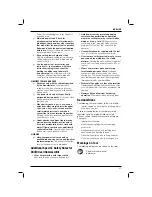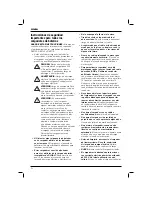
ENGLISH
37
Power tools are dangerous in the hands of
untrained users.
e)
Maintain power tools. Check for
misalignment or binding of moving parts,
breakage of parts and any other condition
that may affect the power tool’s operation.
If damaged, have the power tool repaired
before use.
Many accidents are caused by
poorly maintained power tools.
f)
Keep cutting tools sharp and clean.
Properly maintained cutting tools with sharp
cutting edges are less likely to bind and are
easier to control.
g)
Use the power tool, accessories and
tool bits etc., in accordance with these
instructions taking into account the
working conditions and the work to
be performed.
Use of the power tool for
operations different from those intended
could result in a hazardous situation.
5) BATTERY TOOL USE AND CARE
a)
Recharge only with the charger specified
by the manufacturer.
A charger that is
suitable for one type of battery pack may
create a risk of fire when used with another
battery pack.
b)
Use power tools only with specifically
designated battery packs.
Use of any other
battery packs may create a risk of
injury and fire.
c)
When battery pack is not in use, keep it
away from other metal objects like paper
clips, coins, keys, nails, screws or other
small metal objects that can make a
connection from one terminal to another.
Shorting the battery terminals together may
cause burns or a fire.
d)
Under abusive conditions, liquid may be
ejected from the battery, avoid contact.
If contact accidentally occurs, flush with
water. If liquid contacts eyes, additionally
seek medical help.
Liquid ejected from the
battery may cause irritation or burns.
6) SERVICE
a)
Have your power tool serviced by a
qualified repair person using only identical
replacement parts.
This will ensure that the
safety of the power tool is maintained.
Additional Specifi c Safety Rules for
Drill/Driver/Hammerdrill
• Wear ear protectors with impact drills.
Exposure to noise can cause hearing loss.
• Hold power tools by insulated gripping
surfaces when performing an operation
where the cutting tool may contact hidden
wiring or its own cord.
Cutting accessory
contacting a “live” wire may make exposed
metal parts of the tool “live” and shock the
operator.
• Use auxiliary handles supplied with the tool.
Loss of control can cause personal injury.
• Use clamps or other practical way to secure
and support the workpiece to a stable
platform.
Holding the work by hand or against
your body is unstable and may lead to loss of
control.
• Wear ear protectors when hammering
for extended periods of time.
Prolonged
exposure to high intensity noise can cause
hearing loss. Temporary hearing loss or serious
ear drum damage may result from high sound
levels generated by hammerdrilling.
• Wear safety goggles or other eye protection.
Hammering and drilling operations cause chips
to fly. Flying particles can cause permanent eye
damage.
• Hammer bits and tools get hot during
operation.
Wear gloves when touching them.
Residual Risks
T he following risks are inherent to the use of drills:
– Injuries caused by touching the rotating parts or
hot parts of the tool.
In spite of the application of the relevant safety
regulations and the implementation of safety
devices, certain residual risks cannot be avoided.
These are:
–
Impairment of hearing .
– Risk of squeezing fingers when changing
accessories.
– Health hazards caused by breathing dust
developed when working in wood.
– Risk of personal injury due to flying particles.
– Risk of personal injury due to prolonged use.
.
Markings on Tool
The following pictograms are shown on the tool:
Read instruction manual
before use.
Содержание DC720
Страница 1: ...DC720 DC721 DC722 DC725 DC727 DC730 DC731 DC732 DC735 DC737 DC742 DC743 DC745 www eu ...
Страница 3: ...1 a b c d f e Figure 1 Figure 2 Figure 3 A B g h g h j i ...
Страница 4: ...2 Figure 4 Figure 7 Figure 6 c c c Figure 5 k i ...
Страница 202: ...200 ...
Страница 203: ...201 ...
















































